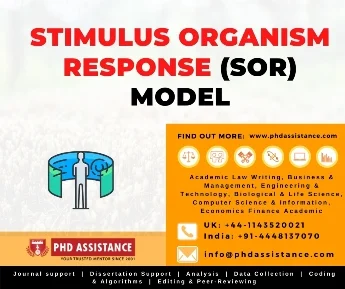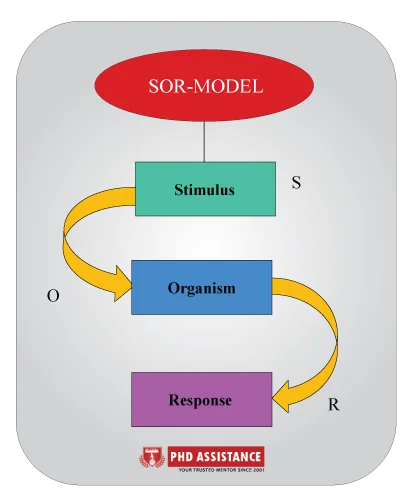Stimulus-Organism-Response (SOR) Model
Introduction
Woodworth, (1929) proposed stimulus-organism-model (S-O-R) as an expansion of Pavlov (2010)’s classic theory of the stimulus–response mode. The stimulus-response model was first procedure to understand the buyer behavior of consumers. The consciousness of the Buyer depends upon the marketing and environmental stimuli while purchase decisions are succefully done with the help of the Buyer’s characteristics and decision process.

Three dimensions of emotional responses
The three dimensions based on the emotional responses to the environment elaborated by Mehrabian and Russel (1974):
- Measuring pleasure regarding the verbal judgments based on the emotions such as happiness, joy, or satisfaction level in some scenarios.
- Arousal can be measured using verbal judgment, such as the person’s happiness level or situation-based activeness.
- Dominance can be predicted using the feelings of the respondent’s indication, which is in the form of willingness to be dominant and based on environmental situation influence. Based on the three dimensions, assume that every individual may affect by emotional conditions by each environment.
In the past decades, stimulus–organism–response (SOR) model has become one of the most commonly used frameworks that integrate input, process and outputs in a single model. To a great extent, this model helps in understanding the causes behind individual’s behavior and hence it is applied in addressing human behavior-related issues. Stimulus-organism-response (S-O-R) model is generally used to examine the association between stimulus and response and to examine how the organisms mediate these relationships. This is carried out through different pathways that provoke the cognitive and emotional states of an individual, which then initiate behavioral responses (Ul Islam & Rahman, 2017). In this model, stimuli (S) induce two opposing types of responses (R) in the user: approach or avoidance. Thus, internal assessments of individuals (O) of several motions in the world produce these behaviors. The below figure represents the SOR model

Figure 1: SOR Model
Also, this model is considered to be best suited for understanding consumer decisions whether to admit and adopt or not (response) as it establishes cognitive appraisal of individuals (stimuli)(apprehensions & facilitating conditions). However, other models such as (Technology acceptance model) TAM, unified technology acceptance and use theory (UTAUT) etc. are constrained and insufficient in elucidating how a stimulus initiates attitude and intention of the consumers (Dzandu et al., 2020). Thus, researchers have adapted the SOR methodology to incorporate complex aspects like cognitive and affective components into the process in their own study settings, due to its widespread applicability (Kim et al., 2020).
Conclusion
Researchers have widely embraced and used the stimulus-organism-response model (S-O-R) to analyse behaviour in the context of social media engagement (Ul Islam & Rahman, 2017), mobile auctions (Chen & Yao, 2018), healthcare (Suess & Mody, 2018), online hotel booking behaviour (Emir et al., 2016). To conclude, the S-O-R model signifies the relation among stimuli in the environment, emotional states of people and the behavior of approach or avoidance which arises from the collaboration of stimuli and emotion.
References
- Chen, C.-C., & Yao, J.-Y. (2018). What drives impulse buying behaviors in a mobile auction? The perspective of the Stimulus-Organism-Response model. Telematics and Informatics, 35(5), 1249–1262.
- Dzandu, M., Pathak, B., & Gulliver, S. (2020). Stimulus-Organism-Response model for understanding autonomous vehicle adoption in the UK.
- Emir, A., Halim, H., Hedre, A., Abdullah, D., Azmi, A., & Kamal, S. B. M. (2016). Factors influencing online hotel booking intention: A conceptual framework from stimulus-organism-response perspective. International Academic Research Journal of Business and Technology, 2(2), 129–134.
- Kim, M. J., Lee, C.-K., & Jung, T. (2020). Exploring consumer behavior in virtual reality tourism using an extended stimulus-organism-response model. Journal of Travel Research, 59(1), 69–89.
- Mehrabian, & Russell. (1974). An approach to environmental psychology.
- Pavlov, P. I. (2010). Conditioned reflexes: an investigation of the physiological activity of the cerebral cortex. Annals of Neurosciences, 17(3), 136.
- Suess, C., & Mody, M. (2018). The influence of hospitable design and service on patient responses. The Service Industries Journal, 38(1–2), 127–147.
- Ul Islam, J., & Rahman, Z. (2017). The impact of online brand community characteristics on customer engagement: An application of Stimulus-Organism-Response paradigm. Telematics and Informatics, 34(4), 96–109.
- Woodworth, R. S. (1929). Psychology (revised edition). Henry Holt & Co., New York.
 Previous Post
Previous Post Next Post
Next Post
